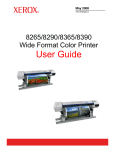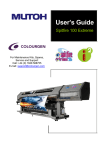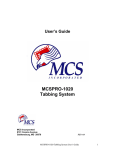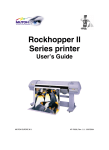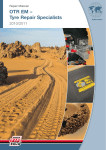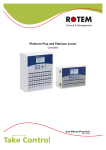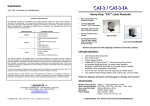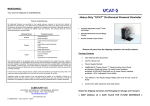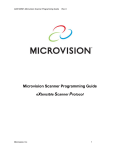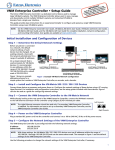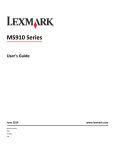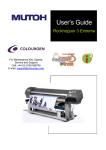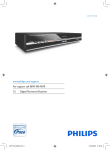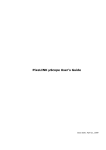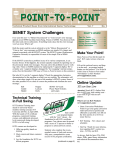Download MCS MicroVision Camera User Manual
Transcript
MicroVision Camera USA User’s Manual 8101 Cessna Avenue Gaithersburg, MD 20879-4164 800.728.0154 tel 301.990.3155 fax www.mcspro.com MCS MicroVision Camera MCSMVCUM1808 • Revision 0 © 2008 MCS Incorporated All rights reserved. MCS retains all ownership rights to all computer programs offered by MCS, their products, and the contents of this manual. The source code for software is a confidential trade secret of MCS. You may not attempt to decipher, decompile, develop or otherwise reverse engineer MCS software, firmware, or products. Information necessary to achieve interoperability is furnished upon request. This manual is furnished under license and may be used or copied only in accordance with the terms of such license. The information in the manual is furnished for informational use only, is subject to change without notice, and should not be construed as commitment by MCS. MCS assumes no responsibility or liability for any errors or inaccuracies that may appear in this manual. No part of this manual may be reproduced, stored in a retrieval system, or transmitted, in any form or by any means, electronic, mechanical, recording, or otherwise, without the express written permission of MCS. Existing artwork or images that you may desire to scan may be protected by copyright law. Be sure to obtain permission for use of existing artwork. Trademarks This product carries the trademark of MCS. All the trademarks of component parts used by MCS in the manufacture of this product are the property of their respective owners. The MCS logo is a registered trademark of MCS. Microsoft and Windows are registered trademarks of Microsoft Corporation. All other brand or product names are trademarks or registered trademarks of their respective companies or organizations. Manufacturer's Statement Limited Warranty, Disclaimer, Limitation of Liability MCS warrants this product for a limited period of time from initial purchase against defects in materials and workmanship. This warranty does not cover damage caused by misuse or abuse of this product or by acts of God or accidents or other causes beyond the control of MCS. Also not covered by this warranty are claims other than by the original purchaser. Your sole remedy and our sole liability to you shall be to repair or replace this product at our discretion if it does not meet the requirements of this warranty. MCS and its distributors shall under no circumstances be liable for any damages arising from the use of or the inability to use this product or from any loss of revenue or profit, business interruption, or other loss which may arise from the use of this product. THE WARRANTIES ABOVE ARE EXCLUSIVE AND IN LIEU OF ALL OTHER WARRANTIES, WHETHER EXPRESS OR IMPLIED, INCLUDING THE IMPLIED WARRANTIES OF MERCHANTABILITY AND FITNESS FOR A PARTICULAR PURPOSE. Contents About this Guide................................................................................. 1-1 Intended Audience ............................................................................................. 1-1 Conventions ....................................................................................................... 1-1 Getting Help ....................................................................................................... 1-1 Getting Started.................................................................................... 2-1 Camera Installation ............................................................................................ 2-1 Camera Placement....................................................................................... 2-1 Physical Installation ...................................................................................... 2-6 Swing-arm Inserter ....................................................................................... 2-8 PLC-type Inserter ......................................................................................... 2-9 IR Track ...................................................................................................... 2-10 Software Installation......................................................................................... 2-11 Dongle Installation ........................................................................................... 2-11 System Power Up ............................................................................................ 2-12 MCS Systems .................................................................................................. 2-12 Read and Print............................................................................................ 2-13 IR Track ...................................................................................................... 2-14 Settings.ini ....................................................................................................... 2-19 Understanding the Interface .............................................................. 3-1 Opening the Application..................................................................................... 3-1 The Main Window .............................................................................................. 3-2 Title Bar.............................................................................................................. 3-2 Menu Bar ........................................................................................................... 3-2 Toolbar............................................................................................................... 3-3 Customizing the Toolbar............................................................................... 3-3 Display Area....................................................................................................... 3-3 Tab Selection Area ............................................................................................ 3-3 Run Tab........................................................................................................ 3-4 Intensity Histogram ............................................................................................ 3-5 Results Area ...................................................................................................... 3-5 Camera Zoom .................................................................................................... 3-5 New, Open, Save, Save As ............................................................................... 3-5 Debug Window................................................................................................... 3-6 Camera Operation and Setup ............................................................ 4-1 Add Camera....................................................................................................... 4-1 Saving Camera Setup .................................................................................. 4-3 TOC-1 Focusing the Camera......................................................................................... 4-4 Remove Camera................................................................................................ 4-5 Properties........................................................................................................... 4-5 I/O Settings ........................................................................................................ 4-6 Running the Auto Setup Feature ....................................................................... 4-7 I/O Timing .......................................................................................................... 4-8 Run .................................................................................................................... 4-8 Stop on Error...................................................................................................... 4-8 Decode Image.................................................................................................... 4-9 Decode on Tool Update................................................................................ 4-9 Reset Pass/Fail Counts ..................................................................................... 4-9 Readable Image Types ....................................................................... 5-1 Printing and Converting Issues .......................................................................... 5-1 Understanding the Camera Tab......................................................................... 5-1 Image Tools.................................................................................................. 5-2 Image Refinement Settings .......................................................................... 5-2 Data Matrix Barcodes ........................................................................................ 5-3 Data Matrix Barcode Template Placement................................................... 5-3 Data Matrix Barcode Tool Configuration ...................................................... 5-4 Linear Barcodes................................................................................................. 5-6 OCR Alphanumerics .......................................................................................... 5-9 OCR Alphanumerics Template Placement................................................... 5-9 OCR Alphanumerics Tool Configuration ...................................................... 5-9 Troubleshooting and Maintenance ................................................... 6-1 Software Diagnostics ......................................................................................... 6-1 Configuration Files........................................................................................ 6-1 Camera Images ............................................................................................ 6-1 Debug Utility ................................................................................................. 6-2 Machine Diagnostics.......................................................................................... 6-2 Configuration Files............................................................................. 7-1 Perfect Match System Settings.ini ..................................................................... 7-1 IR Track System Settings.ini.............................................................................. 7-5 User’s Manual TOC-2 Chapter 1: About this Guide The MicroVision Camera is an integral part of the MCS Perfect Match, IR Track, Input, and Read and Print systems. The camera reads a variety of readable image types and decodes (or passes) the image. The software that accompanies the camera is Windows-based and intended to configure camera operation. Note: The MicroVision Camera is a productivity tool. It is used to In This Chapter • Intended Audience • Conventions • Getting Help assist in print production but not to replace standard quality control procedures. This document describes how to install and use the camera within these systems. For systems that print, this document assumes that you have already installed the MCS Printer software and have read the accompanying User’s Manual. Intended Audience This guide is intended for use by MCS equipment operators. Basic knowledge of the Microsoft Windows® operating system and some experience with MCS printing equipment is assumed. Conventions The following conventions are used in this guide. Convention Description Bold Actions you should take such as text or data to be typed exactly or items to click. Italics Items to type for which you must supply a value. Getting Help A complete on-line help system is available in the interface by selecting the Help item on the Menu bar or the Help icon on the toolbar. 1-1 Getting Help About this Guide If you need further assistance, please contact MCS via e-mail at [email protected] or call 877.MCS.PROZ (877.627.7769). Telephone support for MCS equipment is available 8:30am to 8:00pm EST Monday through Friday and is free of charge. User’s Manual 1-2 Chapter 2: Getting Started The MicroVision camera can help track, verify, and count on many pieces of equipment including inserters. The camera takes a picture of a readable image type and decodes (or passes through) what it sees. How it translates that data is determined by your setup. You can read, match, pass, and print data. In order for this interaction to occur, you must install the camera and the camera software, and set up the camera via the software as well as configure how the camera interacts with the MCS Printer. This chapter describes camera installation and setup. In This Chapter In general, installation should adhere to the following order, assuming that physical installation of all the components, except the camera, has been completed: • MCS Systems • Camera Installation • Software Installation • Dongle Installation • System Power Up 1. If applicable to your setup, install MCS Printer software. See the Array Imaging System Software User’s Manual and GIS 4250 Software User’s Manual for instructions. 2. If printing, create Special Batch files. See “Installing Special Files” on page 2-13. 3. Install MicroVision Camera software. See “Software Installation” on page 2-11. 4. Install the camera dongle and dongle license. See “Dongle Installation” on page 2-11. 5. Install the Camera. See “Camera Installation” on page 2-1. 6. Make any required manual Settings.ini file changes. See “Settings.ini” on page 2-19. 7. Add the Camera(s). See “Add Camera” on page 4-1. 8. Configure Readable Images. See “Readable Image Types” on page 5-1. 9. If printing, print the job. Note: There may be specific instructions based upon the type of MCS system you are using. Be sure to refer to “MCS Systems” on page 2-12 to review descriptions of your system. Camera Installation Camera Placement There is a variety of MCS equipment on which the MicroVision camera can be installed: 2-1 Camera Installation Getting Started • • • • • • • • As an input to other MCS-approved equipment Inserters (Friction-Feeder, Swing Arm) Card Attachers Inkjet Transport Base Continuous Form Transport Base Continuous Form Rewinder Folders Stitchers A camera is triggered by cycle count either from an encoder (electrical/software) or an external trigger (physical device), depending upon camera placement and/or equipment choice. For example, a Pitney Bowes FlowMaster install utilizes an onboard encoder whereas a Swing Arm inserter utilizes external triggers to generate cycle and camera triggers. MCS provides recommendations based on the type of system you are using. Inserters Friction-Feeder Style • User’s Manual 2-2 Camera Placement Option 1 - Facing down toward track, mounted above track Camera Installation Getting Started • Camera Placement Option 2 - Facing up, reading each piece as it exits the feeder • Camera Placement Option 3 - Facing up toward the track, mounted under the track (generally requires modification to track – MCS technicians can determine whether this is possible) In general, when facing up or down in the track, the camera is triggered via the inserter’s on-board encoder. User’s Manual 2-3 Camera Installation Getting Started When the camera is mounted facing up, reading each piece coming out of the feeder, an external trigger source (usually a beam sensor) is used. Additionally, limitations of the read-up configuration are dictated by the placement of the image to decode in relation to the belts of the feeder. Swing-Arm Style • • • User’s Manual 2-4 Camera Placement Option 1 – Facing down toward track, mounted above the track Camera Placement Option 2 – Facing up, reading each piece as it exits the feeder (some limitations may occur on some feeders, as the gears and mechanics of a typical swing arm may prevent placement of the camera on the last feeder. An MCS technician can determine what’s available for mounting) Camera Placement Option 3 – Facing up toward the track, mounted under the track (generally requires modification to track – MCS technicians can determine whether this is possible) Camera Installation Getting Started Swing Arm style inserters are typically set up using an external trigger source. A series of proximity sensors are mounted near the drive shaft, in conjunction with collars that are placed to simulate the timing effect of a cycle count, as well as the camera triggers. An MCS technician will install these and train you on proper adjustment for different jobs. Attacher, Transport Bases, Rewinders, Folders, and Stitchers Normal camera placement on these types of equipment is facing down. These types of camera installs always require an external trigger source, which is usually each individual piece (for cut sheet forms) or a timing mark (for continuous forms). User’s Manual 2-5 Camera Installation Getting Started Physical Installation Physical installation of the camera involves attaching the camera to the device, connecting it to the computer, and installing its driver. Equipment choice dictates whether it will be triggered by an encoder or internal sensor. To install the camera and camera driver: 1. Attach Camera to device. The device can vary and placement can vary depending on the type of printing system used. See “Camera Placement” on page 2-1. 2. Plug the USB cable connector into camera. USB Port Trigger Port Note: Make sure that the USB cable is inserted correctly into the camera port. The Narrow end of the port must match the narrow end of the cable connector. 3. Plug in Trigger cable connections as needed for your setup. See “Equipment Connections” on page 2-7 to evaluate and complete your physical connections. 4. Plug USB cable into the computer’s USB port. A separate USB card is recommended. A Windows Found New Hardware message pops up and the New hardware wizard is launched. 5. Follow the wizard and select Install from Specific Location. 6. Browse to select C:Program Files>MCS Perfect Match>Driver. 7. Click OK. 8. Click Next. The Install PM USB Driver security message appears. 9. Click Continue anyway. 10. Click Finish. User’s Manual 2-6 Camera Installation Getting Started Note: The lens cap must be removed from the camera before use. Equipment Connections The following diagrams provide a typical description of camera connections for a swing-arm inserter, PLC-type inserter, and an IR Track. Note: Additional connections may be needed for inkjet setup. User’s Manual 2-7 Camera Installation Getting Started Swing-arm Inserter Proximity Sensor e-stop Programmable Sensor Exit Sensor Transport MicroVision Controller Camera Dongle Typical Windows XP PC MicroVision Camera USB HUB User’s Manual 2-8 Camera Installation Getting Started PLC-type Inserter Programmable Sensor Diverter e-stop Transport MicroVision Controller PLC-Encoder Panel Camera Dongle Typical Windows XP PC USB HUB MicroVision Camera User’s Manual 2-9 Camera Installation Getting Started IR Track Programmable Sensor e-stop Transport MicroVision Controller Array Print Controller Camera Dongle Typical Windows XP PC USB HUB User’s Manual 2-10 MicroVision Camera Software Installation Getting Started Software Installation The first installation of the camera software is done by an MCS factory trained technician at your facility. Minimum system requirements to perform upgrades are: • • • • Pentium processor Windows XP Professional 1 GB RAM CD ROM drive Note: A serial COM Port connection is needed for the Perfect Match System. There is no way to manually install or uninstall the software on a PC by deleting or copying files. You must run Setup.exe to install the software. To install/upgrade the software: 1. Uninstall any currently installed version using the Windows Remove Programs mechanism. Access this window by selecting Start>Control Panel>Add or Remove Programs and then select the MicroVision Software. Click Remove. 2. Run Setup.exe for the version you would like to install. 3. Follow the setup wizard. Dongle Installation The MicroVision camera software requires a hardware dongle. A dongle is a hardware device that allows your equipment to communicate with the MCS software. If you attempt to use the software without the dongle installed, it will not function. You will receive an error. To install the dongle from the installation CD: 1. From the installation CD, double-click the file DongleInstallation/Hdd32.exe in the Dongle installation folder. This executable installs the drivers to operate the dongle. 2. Follow the instructions. 3. Double-click the file DongleInstallation/DongleReader.exe. This program verifies driver installation and proper operation. 4. Insert the Dongle into a USB port. The dongle operates in any USB port; however, an internal port is recommended for added security. User’s Manual 2-11 System Power Up Getting Started 5. Go to Start>Dalso Coreco>Sapeca>License Manager and click Load License. A window appears with license numbers found. 6. Click the license number for this dongle. 7. Click Open. System Power Up You must power up the PC before the camera box. This order is important because the serial connection will only look for data one time. If the PC is not powered up, camera initialization may fail. MCS Systems The camera can be used with each of the MCS Systems described below: System Description Read and Print The Read and Print configuration of the Perfect Match system combines the camera identification process with the functionality of an MCS inkjet printer. The camera now controls the print order. One camera plus an MCS inkjet for printing. Match The Perfect Match system uses the MicroVision camera to match data matrix barcodes, linear barcodes, and OCR alphanumerics on multiple variable printed pieces. Matches two or more printed pieces. Uses multiple cameras. Match and Print Multiple cameras plus a inkjet printer. Matches and prints. IR Track The MCS IR Track system can work on either a continuous form laser printer or in the continuous form bindery lines to create match jobs with no visible automation marks. This system differs from traditional Read and Print because there is no database associated with the IR Track. What the camera reads from the laser printed material is what is transposed to print in invisible ink. Multiple cameras for the back of the laser printer. Input Camera This system decodes and passes data via serial or ethernet connection to some other piece of equipment. User’s Manual 2-12 MCS Systems Getting Started Read and Print The required items for this setup involve both the inkjet software and camera software. The following text provides a brief description of the needed items. In the Inkjet software, load the job, template, and data file and make sure your setupmatch.cfg file is correctly set. Know your unique identifier in the data file. In the camera software, make the necessary changes for the unique identifier in the Setup.ini file, create/load the camera job, setup the camera and readable images, and enable the job. The following MicroVision Camera functions apply only to setup and operation of the Read and Print system. Installing Special Files MCS has created special files that make it easier for your camera and the MCS Printer to communicate. Once the camera and MCS Printer software have been installed, you can install the special files. These files copy your printer’s Setup.cfg file and make the appropriate changes to the file needed to interact with the camera. When printing, use the file for your setup (Match for Perfect Match or Print for Printers) to invoke the printing software. Note: If you desire changes to your printer’s configuration file and you are using a camera, be sure to make the changes to the .cfg file for the system, not the default Setup.cfg. To install special files: 1. Double-click PrintPCSetup.exe. Two icons are placed on your desktop. These files allow you to run the camera with (SetupMatch file) or without (SetupPrint file) an inkjet. These files will be used when running the job. Enabling the Job After all setup and configuration is complete, you must enable the Read and Print print job from the camera software’s Run tab. The Print button activates the printer and uses any existing MCS Printer settings. You must have the special files installed on your desktop. Missing Records This option can be used only when your MCS Printer is being used in the system. This option can be selected while a job is running. It creates a file that contains a list of how many records are left to print or leftover without printing. You must set the Dupe Checking line in the MCS Printer config file to 1 for this feature to work. User’s Manual 2-13 MCS Systems Getting Started Unique Identifier in the Data File Using the standard MCS Printer data file, place the unique identifier (index number) in a separate field in your data. Once the field is identified, the field number must be updated in the setup file. Note: The data mask in the settings.ini file must match the number of digits (e.g. 7 digits equals #######). Note: You must use leading zeros. Six or seven digits are recommended. The number of digits must be consistent within a file. If you have one million or more, 7 digits is necessary. Do not use the same unique identifier within a job, even if you split the file into multiple segments. The Data Mask is located under the [System] group in the Settings.ini file. See “Configuration Files” on page 7-1 for a detailed explanation of this file. IR Track The IR Track System fits into your current continuous print operations or continuous form bindery line. The system can be used to apply invisible automation marks or as a method to add security information to printed documents. It can even be used to add sort control marks to increase productivity. No database is necessary for the invisible print to be appended. The system reads preprinted unique identifiers and uses that information to print invisible unique identifiers. Once printed, invisible identifiers can be read by User’s Manual 2-14 MCS Systems Getting Started MicroVision cameras. This results in printed pieces with no visible automation marks that can now be matched. The system can mount on a continuous forms table or a forms Rewinder. The following diagram shows the front and back view of a typical installation. In a typical IR Track scenario, pages are printed 2-up with a trigger mark and a unique identifier (such as a bar code) on opposite sides. The trigger/timing mark needs to be a repeatable, detectable object that is the only thing that the sensor will detect within its vertical path. The visible barcode is printed by your continuous laser printer. It is User’s Manual 2-15 MCS Systems Getting Started defined in your document-composition software (i.e., Anchor Max Designer, GMC PrintNet). Both marks are placed in an area to be trimmed off later. The visible barcode is defined as the combined values of the unique identifiers for both records of the 2-up form. For instance, the name on the left may have a unique identifier of “0000001”, while the name on the right side of the 2-up form has a unique identifier of “0723001”. When concatenated together, the left and right side unique identifiers would create the value “00000010723001”, which is created as the visible black barcode in your trim area. The position of the barcode is dependent on the placement of your timing/trigger mark. Generally, it is easiest if they are placed along the same horizontal plane. However, a change in the physical placement of the trigger sensor can affect a change of the User’s Manual 2-16 MCS Systems Getting Started placement of the barcode, thereby changing the placement of the invisible barcodes on the form itself. (The camera that reads the laser printed barcode is immediately triggered by the sensor. Movement of the trigger sensor allows you to move the vertical placement of the barcode.) When the timing/trigger mark is on the same horizontal plane as the barcode, the equipment is set up as shown. Understanding the relationship between the trigger sensor and the camera is vital to the concept of how the IR Track system operates. Below is an example of what happens when the physical placement of the trigger sensor is adjusted. You can print your invisible codes lower on the form. You need to be cognizant of this placement, so that you do not go too far, resulting in the invisible barcodes printing on the next/wrong form. User’s Manual 2-17 MCS Systems Getting Started Determining the Distance from Sensor Define the measurements that are required to print and verify the invisible barcodes. What you see below is considered “Starting Position”. Jog your form to this position (with the sensor directly over the timing/trigger mark). From here, measure the distance from the beginning of the print head to the place on the form where you would like the invisible barcodes to be printed. This is your “Distance from Sensor” value entered in the I/O settings. See “I/O Settings” on page 4-6 for details. Defining Trigger Ticks Value Measure the distance from the center of the camera (mounted behind the print head) to the place on the form where you would like the invisible barcodes to be printed. This is your “Trigger Ticks” value. (Be aware that the value cannot be greater than the length of the form.) Trigger ticks are the value entered in the Settings.ini value as encoder ticks. To define this value, calculate the number of encoder ticks time 300. So, the value entered for encoder ticks with a 5.25 cycles would be 1575. User’s Manual 2-18 Settings.ini Getting Started MCS Input Camera System This system decodes and passes data via serial or ethernet connection (e.g., 509 Caps system as control of GBR Collator on the front of an inserter). Used in this way, the camera decodes and then passes this information to another piece of equipment. The camera has no control over the end use equipment. When using the camera in this fashion, you must enter the camera settings in the configuration file. For each camera, the following settings must be entered. The first camera will have default setting. You can copy the lines and change the camera number for additional cameras. Camera.#.ComPort Camera.#.PassResult Camera.#.FailResult Camera.#.ExternalDecodesOnly Camera.#.BarCodeReadFormat Camera.#.BarCodeNmChars Settings.ini The Settings.ini file contains information specific to your system setup. While .cfg files described in “Installing Special Files” on page 2-13 are created for you, the Settings may require some manual configuration. All settings in the file must match your exact system configuration. For example, the Exit Sensor number in the [System] group must match the input number on the controller box. Certain items must be set in this file and cannot be done via the software. For Perfect Match, these items are: • Data Mask See “Perfect Match System Settings.ini” on page 7-1 for a detailed explanation of this file. In addition, you must also change the Key Field in the TCP/IP section of the SetupMatch.cfg file to reflect the correct field number where the unique identifier is located. If you do set this field you may get invalid comparisons or duplicates. For IR Track, these items are: • • • • • • • • Distance.inches Double.Trigger.Inches Barcode.Num.Digits Trigger.Ticks Read.Mask Write.Mask Piece.Width.Inches Dist.From.Sensor.Inches User’s Manual 2-19 Settings.ini Getting Started See “IR Track System Settings.ini” on page 7-5 for a detailed explanation of this file. User’s Manual 2-20 Chapter 3: Understanding the Interface The MicroVision camera software is a Microsoft Windows-style application. It is important to understand how the interface works so that you may use the interface most effectively. Opening the Application In This Chapter • Opening the Application • The Main Window • Title Bar The MicroVision camera software can be opened in many ways, one of which is described here. Note: Make sure your camera and dongle are connected prior to opening the application. To open the application: 1. Double click the MicroVision icon on your desktop. Note: You may open the application using other Windows standard techniques. • Menu Bar • Toolbar • Display Area • Tab Selection Area • Intensity Histogram • Results Area • Camera Zoom • New, Open, Save, Save As • Debug Window 3-1 The Main Window Understanding the Interface The Main Window The Main Window is the primary point of entry for all tasks. This window is broken down into many areas as annotated below. Each area is described in the sections that follow. Title Bar Menu Bar Tab Selection Area Toolbar Intensity Histogram Display Area Results Area Title Bar The Title Bar displays the name of the program, a minimize button, a maximize/restore button, and a close button. Menu Bar This standard Windows feature contains pulldown menus to select functions. Functions which cannot be used appear dimmed (gray). Items in the Menu Bar are interactive. They change as tabs are selected in the tab selection area. User’s Manual 3-2 Toolbar Understanding the Interface Toolbar The Toolbar contains rows of iconic buttons that provide quick access to common tasks. Save New Run Open Add Camera Customizing the Toolbar The customize option allows you select which icons are shown in the toolbars. To change icons displayed in toolbars: 1. Select Customize from the View menu and select the desired toolbar to change. The toolbar window appears. 2. Use the Add and Remove arrow buttons to change the icons displayed. 3. Click OK. Display Area The display area is the area in which functions appear. When you select a tab in the tab selection area, the display area is repopulated with that information. You then work within the display area to execute your tasks. Tab Selection Area The tab selection area contains three tabs: Camera, Log, and Run. Selecting a tab changes the display area. The Camera tab is described in detail in “Camera Operation and Setup” on page 4-1. The Log tab provides a history of actions performed as well as errors and warnings. The Run tab is described below. User’s Manual 3-3 Tab Selection Area Understanding the Interface Run Tab The Run tab provides status while the job is run. Note: You can also enable a Read and Print print job from the Run tab. Lights show read activity and camera status. Printing status lights show if on and flashes when printing. The registration sensor flashes once per cycle. The exit sensor flashes when it is tripped. The output sensor flashes as well when it is tripped. The Clear button physically clears all pieces on the list while Clear Blues clears pieces only between the exit sensor and the printer. These option are not available for IR Track systems. When running, the table displays only those display columns that were requested during I/O settings configuration. See “I/O Settings” on page 4-6. User’s Manual 3-4 Intensity Histogram Understanding the Interface The following table describes run colors. Color Description Green Success Red Failure Yellow Duplicate Read Pink Match so far - only pertinent with multiple cameras reading the same image type. Tan Invalid key. This may appear when what is passed to the inkjet is not in the data file. It may be misidentified in the data file. Intensity Histogram The Intensity Histogram is located on the bottom left of the window. It shows the intensity of dark and white spaces for the camera to read. It adjusts peak black and white valley use as indicated by a dividing line that specifies one side of the line is black and the other white. Results Area The results area lists your current actions and details about those actions. Camera Zoom Camera zoom, accessible via the View menu, increases or decreases the size of the picture shown in the display area. It does not increase or decrease the actual picture image. New, Open, Save, Save As Use these settings available in File menu to create, save, and open your current camera settings. User’s Manual 3-5 Debug Window Understanding the Interface Debug Window To access most of the configuration files and troubleshooting files you need, press CTRL-ALT-3. In addition to the files accessed via this window, you may also need to click icons which are located on your desktop. User’s Manual 3-6 Chapter 4: Camera Operation and Setup This section explains how to add and configure your camera(s) as well as how to review its operational status. In This Chapter • Add Camera • Focusing the Camera Add Camera Once your camera(s) and software are installed you must add your camera(s) to be recognized by the software. A camera can be plugged in to the computer and the software may be open, but the camera will not be recognized until it is added. Note: It is helpful to know the serial number of your camera(s) before executing this procedure. • Remove Camera • Properties • I/O Settings • Running the Auto Setup Feature • I/O Timing To add a camera: • Run 1. Make sure the camera is properly installed and connected. • Stop on Error See “Camera Operation and Setup” on page 4-1. Note that the bottom right corner of the screen indicates the number of cameras available. This lets you know how many cameras are plugged into the computer that have not been added to the software. After you add a camera, the status reads 0 cameras available. • Decode Image • Reset Pass/Fail Counts 2. Select the Camera Tab. 3. Click the Add Camera icon. 4-1 Add Camera Camera Operation and Setup The Add Camera Window appears. Serial Numbers 4. Select the serial number for the camera you are adding. If you do not know the serial number of your camera, you can select any serial number in the list and look at the installed cameras to see which one is flashing. If the desired camera is not flashing, select another serial number until you locate the desired camera. 5. Assign a number to the camera. You can assign any number to the camera. Multiple numbers are listed no matter how many cameras you have installed. We recommend that cameras are numbered according to placement on the inserter and not based on the order they were added. Select a number and click Assign. 6. Click Exit. User’s Manual 4-2 Add Camera Camera Operation and Setup The display area now shows the camera image. Saving Camera Setup You can save the camera assignment by modifying the MicroVision camera configuration file. To save current camera settings: 1. Select Save from the File menu. 2. Provide a name for the file and click Save. You can open this file the next time you use the software. Tip: You can save the camera setup and have it reopen with this setup active the next time you open the camera software. To do this: 1. Press CTRL-ALT-3. The debug window appears. 2. Click the MicroVision Settings.cfg button. A text window appears. 3. Modify the third line to equal 1. 4. Save the file. 5. Close the MicroVision camera software. 6. Reopen the MicroVision camera software User’s Manual 4-3 Focusing the Camera Camera Operation and Setup Focusing the Camera You can focus the camera by adjusting the camera lens position. This is done using the set screw. It is important to follow the procedure below to ensure that the screw is not dislodged and that no damage is done to the camera or lens during this operation. To adjust camera focus: 1. Hold the camera straight and using the tool provided, insert the tool through the set screw access hole into the set screw. 2. Turn the tool a half turn to the right. 3. If you have successfully caught the set screw, it will turn no further. If your tool keeps turning, you have not caught the set screw. Remove the tool and try again. 4. Once you have successfully caught the set screw, turn it a half turn counter-clockwise. User’s Manual 4-4 Remove Camera Camera Operation and Setup 5. You may now grab the lens with your fingers and turn it as needed. 6. When your adjustment is complete, return the set screw to the locked position. Make sure you have correctly caught the set screw as in steps 1-3 before turning. Remove Camera This feature, accessible from the File menu, removes a camera that had been added. The camera may remain connected to the computer, but it will not be recognized by the software. Properties The Properties window, accessible from the Camera menu, provides status on the currently selected camera. It tells you information such as the camera’s number and serial number. User’s Manual 4-5 I/O Settings Camera Operation and Setup I/O Settings The I/O settings window allows you to specify parameters about how the camera detects pieces on the printer. It is especially important that your Cycles From Exit settings be correct in this window to ensure proper setup. The MicroVision Camera software can operate with an encoder to trigger the camera or with a physical sensor. The I/O settings window displays different options, depending on your setup. To enter I/O settings on a system with an encoder: 1. Select I/O Settings from the File menu. 2. Enter Cycles from Exit and Delay settings for each camera. The number of cycles represents how many cycles of the machine are between the camera and the exit sensor. Delay is the number of ticks in the cycle at which you want the camera to be triggered for systems using an encoder. For Flowmaster configurations, you can get the encoder ticks value from the timing screen. 3. If you have a diverter, enter Diverter settings. User’s Manual 4-6 Running the Auto Setup Feature Camera Operation and Setup Check the box to enable the diverter. When enabled, the cycle offset is always one less than the primary camera’s cycles from exit setting (e.g., the camera’s cycle is 12, the diverter setting is 11). 4. For Read and Print systems, enter Printer Settings. When enabled, display columns are the fields in the data file that you want displayed in the Run tab. These are usually the most important fields such as the unique identifier field for camera decoding. See “Run Tab” on page 3-4 for a description of this tab. 5. Enter Stop Conditions. Stop conditions are settings that you can define to stop the transport. They are used to address any need for intervention. If the numbers are sequential and you want to verify this order, check the Stop machine if read numbers are not sequential check box. This action is helpful to double check that there are no missing pieces. 1 indicates a high to low read and -1 indicates a low to high read. If they are not sequential, this feature is not applicable. It is particularly helpful to use this feature with OCR data. Be sure to check the box when running sequential OCR data. Misreads and mismatches have values of 0 for off. Enter a threshold of misreads before a stop. This field may also be used when there is no diverter. Mismatch is used when multiple cameras are being used to tell the system to stop when values are not equal from one camera to another. When using a printer, the number of pieces indicates how many pieces can go past the exit sensor without reaching the actual printer before printing will stop. This setting can avoid a pile up at the print head. These are identified as blue lines on the Run tab. The number entered is the maximum load plus one. For example, if the physical number of pieces that fit is 5, the number entered is 6. Running the Auto Setup Feature You can also set the cycles and delay settings via the Run tab. This provides accurate setting for these fields but can’t be done until you have installed everything else and configured a readable image. Its important to optimize these settings so that the exit sensor alerts at the proper time. To get the settings: 1. Click the Run tab. 2. Press CTRL-ALT-3. 3. Click Settings.ini. User’s Manual 4-7 I/O Timing Camera Operation and Setup 4. Go to the System group and on the first line change Setup Mode to 0. Save the file. 5. Save any current Camera software settings. 6. Close the Camera software. 7. Reopen the Camera software. The cycles and delay information in the I/O Settings window has been updated. I/O Timing When pieces are running, you can look at this screen to view timing status. To display I/ O timing status, select I/O Timing from the File menu. If printing, an acknowledgement can also be included. Run The Run feature, accessible from the File menu, takes the camera in and out of decode mode. Stop on Error When enabled, this feature, accessible from the File menu, displays the errored image on screen. The Clear Stop Error removes the image from the screen. This is useful when reading OCR characters. It can help identify all characters that need training. User’s Manual 4-8 Decode Image Camera Operation and Setup Decode Image When a tool is selected, you can use this option from the Camera menu to decode the image. Decode on Tool Update When enabled, images are automatically decoded when updates are made to the tool. Reset Pass/Fail Counts This feature resets the Pass/Fail counts displayed in the Results table for each tool. User’s Manual 4-9 Reset Pass/Fail Counts Camera Operation and Setup User’s Manual 4-10 Chapter 5: Readable Image Types The MCS MicroVision camera software reads Data Matrix barcodes, linear barcodes, and OCR alphanumerics. It is recommended that you read The Bar Code Book by Roger C. Palmer (ISBN 0-911261-13-3) to gain a comprehensive understanding of bar codes. The items in this section pertain to readable image type descriptions with regard to the MicroVision camera. Printing and Converting Issues When using either barcodes or OCR alphanumerics, it is important to realize that the print quality from your laser printer and your conversion process quality are critical for successful reads with the matching system. In This Chapter • Printing and Converting Issues • Understanding the Camera Tab • Data Matrix Barcodes • Linear Barcodes • OCR Alphanumerics When you start printing a job with your laser printer, make sure you incorporate quality control procedures regarding the barcode or OCR alphanumerics. Look for erroneous printing of dots or fuzzy printing. If the entire run is produced with faulty barcodes or OCR alphanumerics, there is little you can do to make it work. When the document is converted (cut and/or folded), it is critical that the cut and fold be identical on every form. The camera is looking at one spot to read the data, and if the pieces are folded even slightly differently, the image will not be properly decoded. Understanding the Camera Tab The Camera tab provides access to the camera image, readable image tools, and image refinement settings. 5-1 Understanding the Camera Tab Readable Image Types Image Tools Image tools decode the image that the camera sees. To configure how the tool decodes the image, click on that tool’s icon. Once the tool has been configured, you can modify the tool setting by clicking the Tool Properties icon. Configured tools are listed in the tool Results area. When a tool is correctly reading an image it is displayed white with Pass text and when it is not, it is red with Fail status. You can also access the tool’s configured settings by double-clicking the tool’s row in the tool result area. To remove a tool, click the Remove tool icon. The Blue Rectangle tool allows you to narrow the readable area from the full screen to size of the blue box. This helps the camera software ignore the extra noise, thereby increasing decode speed. Image Refinement Settings The image refinements settings (exposure, gain, orientation, and trigger) adjust the clarity of the image displayed. Expose adjusts the amount of light allowed in. Gain adjusts the contrast based on the amount let in. It is best to leave the Exposure a bit lower and raise the Gain if possible. Be careful not to adjust the gain too high. This will produce a grainy image. User’s Manual 5-2 Data Matrix Barcodes Readable Image Types Orientation adjusts the rotation of the image. OCR requires that the image is read left to right. It does not matter for other image types. The capture below shows an image after image refinement has been performed. The trigger can be set to External, which detects actions from the machine, or Internal from the software, which executes consecutive firing. In production mode, the trigger mode must be set to External. Decode must always be On in production mode. Data Matrix Barcodes Data Matrix Barcode Template Placement The following items provide some specifications for how to place data matrix bar codes in the MCS Printer software template. • • • • Size >= ¼”, <= 1 ½” Cell Size <=12 cells DPI >= 300 dpi Clear Zone - an area surrounding the image that has nothing but white space The clear zone must have no other print in area. The Data Matrix barcode can be printed anywhere that the camera can see it on the inserter. The data in the data matrix barcode should be only the unique identifier. Leading zeros are required to give the barcode a uniform size though out the job. User’s Manual 5-3 Data Matrix Barcodes Readable Image Types Data Matrix Symbol Sizes Numeric Alphanumeric Symbol Size 6 3 10 x 10 10 6 12 x 12 16 10 14 x 14 24 16 16 x 16 36 25 18 x 18 44 31 20 x 20 60 43 22 x 22 72 52 24 x 24 88 64 26 x 26 124 91 32 x 32 172 127 36 x 36 228 169 40 x 40 288 214 44 x 44 348 259 48 x 48 408 304 52 x 52 560 418 64 x 64 736 550 72 x 72 912 682 80 x 80 1,152 862 88 x 88 1,392 1,042 96 x 96 1,632 1,222 104 x 104 2,100 1,573 120 x 120 2,608 1,954 132 x 132 3,116 2,335 144 x 144 10 6 8 x 18 20 13 8 x 32 32 22 12 x 26 44 31 12 x 36 64 46 16 x 36 98 72 16 x 48 Data Matrix Barcode Tool Configuration The way the camera decodes the Data Matrix barcode image is configured via the Data Matrix Image tool. To configure Data matrix readability: 1. Click the Camera tab. User’s Manual 5-4 Data Matrix Barcodes Readable Image Types 2. Click the Data Matrix tool. The Data Matrix Tool Properties window appears. 3. If desired, enter a name for this configuration. If you do not enter a name, a name will be provided for you. 4. Enter the decode Timeout. The decode time sets how long the camera is given to read the image before a misread is reported and the camera moves on to next image. Typically this is left at 50 seconds. The number should never be increased over the speed at which you are running. For example, if you are running at 10,000, the number should not be more than 100 (1/10000 equals .0001 which equals 100 ms). 5. Review the Character Length. This sets how many digits are in the unique identifier. Enter the correct amount of pound signs to match the number of digits in the unique identifier field. You can use symbols such as (-) or (A) to skip or replace a digit. In the Test field, enter numbers equaling the required digits to test that the correct amount of pound signs have been entered. The results field will display what will be read if the test numbers were decoded. ##### with test data of 12345 will display 12345 in the results field; while A#### will display A2345 and #-### will display 1345. 6. Enter the Matrix size. Do not use the Automatic setting. Select the correct size. To find the correct size, count the number of black and white spaces for length and width, See “Data Matrix Barcode Template Placement” on page 5-3 above for explanation on bar code sizes. 7. Enter Calculate Light on Dark settings. Dark on light is used for visible barcodes. Light on Dark is used for invisible barcodes. Note: Invisible barcodes require the use of the invisible barcode camera. 8. Click Threshold. User’s Manual 5-5 Linear Barcodes Readable Image Types The Threshold window appears. This window brings up the camera image and allows you to adjust the black areas outside of the image. 9. Enter Threshold settings. The Adaptive Global, Adaptive Local, and Fixed settings allow you to adjust the amount of black and white space displayed around the image. Adaptive Global adjusts the circle around the image to the maximum image allowed by the camera. Local reduces the area closest to the image. Fixed allows you to manually adjust the area and is the most commonly used format. 10. Click OK. 11. Check additional options. You can enable Log reads to enter data in the log file. Checking Outline Read places a green outline around the image based on your threshold settings. You can show the Thresholds settings and you can enable the Calculate grade option. The Calculate grade option provides a score on barcode matching. Note: Do not check Calculate grade while the job is running. This is will slow down performance. Linear Barcodes Some Linear barcodes may not fit in the field of view of the camera. The typical field of view is 1.25 inches. If the bar code is larger than 1.25 inches, the camera can not read it. Linear barcodes are configured in similar fashion to Data Matrix barcodes. User’s Manual 5-6 Linear Barcodes Readable Image Types To configure Linear barcode readability: 1. Click the Camera tab. 2. Click the Linear Barcode tool. The Linear Barcode Tool Properties window appears. 3. If desired, enter a name for this configuration. If you do not enter a name, a name will be provided for you. 4. Enter the decode Timeout. The decode time sets how long the camera is given to read the image before a misread is reported and the camera moves on to next image. Typically this is left at 50 seconds. The number should never be increased over the speed at which you are running. For example, if you are running at 10,000, the number should not be more than 100 (1/10000 equals .0001 which equals 100 ms). 5. Review the Character Length. This sets how many digits are in the unique identifier. Enter the correct amount of pound signs to match the number of digits in the unique identifier field. You can use symbols such as (-) or (A) to skip or replace a digit. In the Test field, enter numbers equaling the required digits to test that the correct amount of pound signs have been entered. The results field will display what will be read if the test numbers were decoded. ##### with test data of 12345 will display 12345 in the results field; while A#### will display A2345 and #-### will display 1345. 6. Select the barcode type form the list. 7. Enter Calculate Light on Dark settings. Dark on light is used for visible barcodes. Light on dark is used for invisible barcodes. Note: Invisible barcodes require the use of the invisible barcode camera. User’s Manual 5-7 Linear Barcodes Readable Image Types 8. If a checksum characters appears with your barcode, enable the Checksum Character feature. 9. Click Threshold. The Threshold window appears. This window brings up the camera image and allows you to adjust the black areas outside of the image. 10. Enter Threshold settings. The Adaptive Global, Adaptive Local, and Fixed settings allow you to adjust the amount of black and white space displayed around the image (and is the most commonly used format). Adaptive Global adjusts the circle around the image to the maximum image allowed by the camera. Local reduces the area closest to the image and Fixed allows you to manually adjust the area. The Line intensity graph tells you to draw a line completely through the image. It then displays the intensity highs and lows. Keep drawing lines until you end up in the middle to achieve the best readability. 11. Click OK. You can enable Log reads to enter data in the log file. Checking Outline Read places a green outline around the image based on your threshold settings. You can show the Thresholds settings. User’s Manual 5-8 OCR Alphanumerics Readable Image Types OCR Alphanumerics 12345 The camera can decode OCR alphanumerics. You must train the software to read the numbers properly. This may take some time, as for each job each character must be trained. Note: The OCR alphanumeric must be read left to right. You can change the orientation of the camera image via “Image Refinement Settings” on page 5-2 to ensure proper readability. OCR Alphanumerics Template Placement The following items provide some recommendations for how to place OCR alphanumerics in the MCS Printer software template. • • • • Size >= 6 pt <= 8 pt Font OCR A, or OCR B DPI >= 300dpi Clear Zone - an area surrounding the image that has nothing but white space. Although the MicroVision camera software can learn many fonts for OCR, we recommend standardizing on OCR A or B, since they are Fixed Pitch Fonts, rather than Proportional Pitch Fonts. Fixed Pitch means that each character is the same size (particularly width), which is necessary for a uniform identification of OCR. It is recommended that the software be standardized on a seven digit number to avoid duplicate printing. All numbers should have leading zeros, for example, “0002456”. OCR Alphanumerics Tool Configuration The OCR Alphanumerics tool allows you to configure how the camera decodes the OCR image. You can save the trained characters and use them for similar jobs. To configure OCR alphanumerics: 1. Click the Camera tab. 2. Click the OCR Tool icon. A message appears asking you if have existing configurations. 3. Click Yes to select from a list of existing setups or No to create a new setup. User’s Manual 5-9 OCR Alphanumerics Readable Image Types If Yes, a list of existing setups appears. Select the desired item from the list and click OK. If No, a Save dialog appears requesting a name for this file. Provide a name, click Save, and proceed with the steps remaining in this procedure. 4. Enter the decode Timeout. The decode time sets how long the camera is given to read the image before a misread is reported and the camera moves on to next image. Typically this is left at 50 seconds. The number should never be increased over the speed at which you are running. For example, if you are running at 10,000, the number should not be more than 100 (1/10000 equals .0001 which equals 100 ms). 5. Review the Character Length. This sets how many digits are in the unique identifier. Enter the correct amount of pound signs to match the number of digits in the unique identifier field. You can use symbols such as (-) or (A) to skip or replace a digit. In the Test field, enter numbers equaling the required digits to test that the correct amount of pound signs have been entered. The results field will display what will be read if the test numbers were decoded. ##### with test data of 12345 will display 12345 in the results field; while A#### will display A2345 and #-### will display 1345. 6. Enter Calculate Light on Dark settings. Dark on light is used for visible barcodes. Light on dark is used for invisible barcodes. 7. Enter the Minimum score. User’s Manual 5-10 OCR Alphanumerics Readable Image Types OCR is the comparison of the trained shapes to the shapes the camera picks up on the image. No image will match trained characters 100% due to general printing imperfections; therefore, a minimum score is used for comparison. 70% is the recommended minimum score. 8. Click Threshold. The Threshold window appears. This window brings up the camera image and allows you to adjust the black areas outside of the image. For OCR images you need to configure blob settings. 9. Click Outline Blobs. There may be some background images close to or surrounding the actual numbers. User’s Manual 5-11 OCR Alphanumerics Readable Image Types Note: You can also use the blue rectangle later to narrow the visible area and eliminate blobs. 10. Enter Threshold settings. Reduce the numbers until the actual OCR is readable but not distorted. 11. Click OK. 12. Use your arrow keys to highlight a question mark in the read field. The alphanumeric pertaining to that position flashes. 13. To train, enter the number you wish the flashing item to be recognized as. 14. Click Train. User’s Manual 5-12 OCR Alphanumerics Readable Image Types Outlines turn green when trained. Alphanumerics should only be trained one time, even if they appear multiple times in a particular image. Multiple training of alphanumerics will slow down processing. 15. Repeat this recognition (steps 1-14) for every alphanumeric needed. This may take some time. Trained numbers are listed in the table. You can delete and retrain items as needed. 16. Check additional options. You can enable Log reads to enter data in the log file. Checking Outline Read places a green outline around the image based on your threshold settings. You can show the Thresholds settings and you can enable the Calculate Grade option. The calculate grade option provides a score on barcode matching. User’s Manual 5-13 OCR Alphanumerics Readable Image Types User’s Manual 5-14 Chapter 6: Troubleshooting and Maintenance The following sections can help you troubleshoot printing problems. The troubleshooting tables below can help you identify common problems. In This Chapter When problems occur, MCS asks that you run the Debug utility prior to contacting technical support. This will help us more quickly identify the problem and provide a solution. • Machine Diagnostics • Software Diagnostics Software Diagnostics A variety of diagnostics tools are available through the Diagnostic interface accessed via CTRL-ALT-3. Configuration Files You can access the configuration files used to make advancedlevel changes to software operation. Camera Images You can save and load the images to help isolate specific decoding issues. 6-1 Machine Diagnostics Troubleshooting and Maintenance Debug Utility To run the Debug Utility: 1. With the camera software open, press CTRL-ALT-3. The Debug window appears. 2. Click Connect to the Debugger. 3. Minimize the spy window. 4. Click Connect to Debugger a second time. Debug information is placed in the spy window. 5. E-mail debug information to [email protected]. Machine Diagnostics This feature tests for printing and camera operation. Note: Swing arm operation is not supported in this feature. To enter I/O test: 1. Select I/O Test from the File menu. 2. Select one of the desired testing operations. User’s Manual 6-2 Button Operation Activate Diverter Activates the diverter station to test if misreads are being sent to the bin. This helps verify that system keeps running even when errors occur. Activate e-stop Activates e-stop to verify proper operation. Test serial connection Establishes a connection to verify connectivity. Trigger Camera Test fires the camera through the controller to verify connectivity. Chapter 7: Configuration Files The following tables describe each line of the settings file for a variety of MCS systems. Perfect Match System Settings.ini Setting Description [System] System-level settings Setup Mode=0 Used to set up the machine with the software. Encoder Present=1 1 is used for an external encoder. 0 if you were using collars for the cycle and encoder tics. Encoder Reset Sensor=4 Encoder Reset is used when installing an external encoder such as the one used on the MCS inkjet (RSI). This gives the encoder a starting point, which resets with a collar sensor. Encoder StartStop Msecs=500 Tells the encoder when to reset when using an external encoder such as a flow master. Cycle Trigger Ticks=0 Used for the centering of the Exit sensor in a given cycle. Resets the zero point. Cycle Sensor=0 ;0=Encoder-triggered Cycle comes from a 0 (encoder) or a 1 collared sensor (Trigger) . Exit Sensor=1 Used to calculate your cycles. You may also change where your input would be. The exit sensor can be put in any of the four inputs on the IO box. You just need to change the number. This must match the physical input number on the controller. Output Sensor=2 The output sensor is used to catch a missing piece after the exit sensor. If there is no piece, the system will shut down. This must match the physical output number on the controller. Data Mask Data Trim Sensor Invert Bitfield=00000001 Sensor Active Polarity=00000000 Misread Trigger Count=0 Mismatch Trigger Count=0 Print Que Len Trigger Count=5 Enforce Sequential Reads=0 Sequential Increment=1 Ignore Leading Cam Reads=1 Ignore Exit Sensor on Encoder Stop=1 Dupe Checking Enabled=0 Enable Output Check=0 Output Clear On Stop=0 Trigger Variance=0.4 7-1 Perfect Match System Settings.ini Configuration Files Setting Description Cam Read Variance=0.05 Auto Print Mode=1 ;0=Never,1=On Cycle,2=On Encoder Start [Selective Inserting] Enabled=0 Polarity=0 Pre-Data Delay=5 Latch Pulsewidth=10 Post-Data Delay=5 Feeder1 Field =6 Feeder2 Field =7 Feeder3 Field =8 Feeder1 Number=4 Feeder2 Number=5 Feeder3 Number=6 [Sensor Debounces] Sensor1 Debounce Count = 50 ;Exit Sensor Sensor2 Debounce Count = 0 ;Output Sensor Sensor3 Debounce Count = 0 ;Spare Sensor Sensor4 Debounce Count signal =0 Sensor5 Debounce Count = 100 ;Camera1 Trigger Sensor6 Debounce Count = 100 ;Camera2 Trigger Sensor7 Debounce Count = 100 ;Camera3 Trigger ;Encoder1 "Sync" Sensor1 Debounce Count Source = 1 ;0=>Encoder1 ticks, 1=>Milliseconds Sensor2 Debounce Count Source = 0 ;0=>Encoder1 ticks, 1=>Milliseconds Sensor3 Debounce Count Source = 0 ;0=>Encoder1 ticks, 1=>Milliseconds Sensor4 Debounce Count Source = 0 ;0=>Encoder1 ticks, 1=>Milliseconds Sensor5 Debounce Count Source = 1 ;0=>Encoder1 ticks, 1=>Milliseconds Sensor6 Debounce Count Source = 1 ;0=>Encoder1 ticks, 1=>Milliseconds Sensor7 Debounce Count Source = 1 ;0=>Encoder1 ticks, 1=>Milliseconds [Camera 1] IP=localhost Enabled=1 Cycles From Exit=13 User’s Manual 7-2 Perfect Match System Settings.ini Configuration Files Setting Description Trigger Source=0 ;0=encoder,5=Trig-1,6=Trig-2,etc. Trigger Tick Count=1 [Camera 2] IP=localhost Enabled=1 Cycles From Exit=11 Trigger Source=0 ;0=encoder,5=Trig-1,6=Trig-2,etc. Trigger Tick Count=1 [Camera 3] IP=localhost Enabled=1 Cycles From Exit=9 Trigger Source=0 ;0=encoder,5=Trig-1,6=Trig-2,etc. Trigger Tick Count=1 [Printer] IP=localhost Enabled=0 Port Number=700 Field1=1 Field2=2 Field3=3 Field4=4 [Diverter] Enabled=1 Output=1 Cycle Offset=12 Delay Source=0 ;0=encoder,1=millisec timer Delay Ticks=0 Delay Time=0.0 [I/O] Comm Port=1 Comm Baud=115200 EStop Output=2 [Log] Folder=C:\ Date-Time Format="%m%d%y-%H%M%S" ;log?, e-stop?, trigger count, log code, log text, EStop Message App Open = 1,0,1,A,Program Start App Close = 1,0,1,B,Program End Transport Stop = 1,0,1,C,Transport Stop User’s Manual 7-3 Perfect Match System Settings.ini Configuration Files Setting Description Transport Start = 1,0,1,D,Transport Start Piece Fail = 1,0,1,E,Piece Fail Piece Success = 1,0,1,F,Piece OK Piece Removed = 1,0,1,G,Piece Removed Duplicate Piece = 1,0,1,H,Piece Duplicated Invalid Key = 1,1,1,I,Invalid Key [Debug] Enabled=1 Debug Filename= Show Timestamps=1 Mask=-1 User’s Manual 7-4 IR Track System Settings.ini Configuration Files IR Track System Settings.ini Setting Description [System] Encoder.Ticks.Per.Inch = 300 This is the unit of measure that the system will use; It will always be set to 300. Run.Screen.List.Len Represents the number of lines you want to view on the Run Tab. Setup.Mode Password = 32 =0 Disables all EStops and their Dialogs = MCS Time.Stamp.Ratio = 0.05 [Registration Mark] Distance.Inches = 14 Represents the distance between registration marks on your form; it is generally the size of your form (11" form, 17" form, etc.).Distance between registration marks. Required Manual Setup Double.Trigger.Inches = 13 Represents the distance you want surveyed for double detection; if the trigger sensor is tripped this value (X) or less from the last trigger, it will send a E-Stop signal to the rewinder, indicating a "Double Detect". This usually indicates that the sensor has been triggered by something in addition to the registration mark. This value is always entered as 1 inch smaller than the Distance.Inches value. ;EStop if mark detected this distance or less from previous. Required Manual Setup Missing.Trigger.Count = 2 Indicates the threshold for the number of registration marks that can be missed before an E-Stop signal will be sent; the system monitors the number of encoder ticks that have occurred since the last trigger -- if the value reaches Missing.Trigger.Count times the Encoder.Ticks.Per.Inch, then an error pops up on screen indicating that X number of forms have passed without seeing a registration mark. ;EStop if this many successive registration marks missed. [Camera 1] Read Camera Trigger.Ticks =0 A delay mechanism for tripping the camera. It uses encoder ticks as a unit of measure. This value is recommended to always stay at 0. ;Trigger camera N encoder ticks after registration mark. Required Manual Setup Barcode.Num.Digits = 14 The number of characters or digits that the barcode in your trim area represents. For instance, if the barcode was created from a 16-digit number, then you would enter 16 on this line. ;Number of digits encoded in laser barcode. Required Manual Setup Derive.Misread.Barcodes = 1 This line item lets the IR Track software determine the next barcode in sequence, in case it doesn't actually read it. The value is either 1 (On) or 0 (Off). This can only be used when the Trim Area barcodes (printed by your laser printer) follow a pattern. If the numbers are in random order, then this function must be turned off (0). ;Derive barcode if camera misreads . Derive.Sample.Len The threshold number of barcodes that need to be read successfully AND in succession, to determine the pattern for the derive function. Any value less than 3 is not recommended. ;Verify sequence for this many pieces before allowing derives. Misread.Trigger.Count [Camera 2] =3 =5 The threshold number for missed or derived Trim Area barcodes to occur before an E-Stop message is sent ;EStop if this many successive misreads/ derives occur. Verify Camera 1 User’s Manual 7-5 IR Track System Settings.ini Configuration Files Setting Enabled Trigger.Ticks Description =1 Value is either 1 (on) or 0 (off). = 2400 This value is the distance that your continuous form will travel after the Trigger Sensor is tripped until the Verify (Invisible) camera will fire. It is measured in Encoder Ticks (unit of measurement is always 300). To determine this value, you measure the distance with a ruler, and then multiply that number by 300. This value can NEVER be greater than the distance between registration marks. ;Trigger camera N encoder ticks after registration mark. Required Manual Setup Read.Mask = ####### Write.Mask = ####### This entry is to define the characters that you want to compare from Camera 1 successful read. A # sign indicates that the character located at that position in the string is to be used for comparison. A “-” sign indicates that the character located at that position is to be ignored during comparison. In this example, the first 7 characters are the only ones to be considered for matching status, while the last 7 are being ignored.;#=copy digit, -=skip digit, other=replace digit. Required Manual Setup This entry is to define the number of characters to be compared for matching purposes. The number of "#" signs must equal the number of "#" signs defined in the Read.Mask line above it. ;#=copy digit, other=replace digit. Required Manual Setup Misread.Trigger.Count = 5 Defines the threshold of consecutive misreads before a stop signal is to be sent to the system. ;EStop if this many successive misreads occur Fire.Sequence Defines the pattern at which the Verify camera will occur. This is ALWAYS 16 characters in length. In this example, the first piece will be verified, the second is not, the third piece is verified, etc., etc., etc.... ;1=Fire, 0=Skip Piece (16 digits) = 1010101010101010 [Camera 3] Enabled Trigger.Ticks Verify Camera 2 =1 = 2400 Trigger camera N encoder ticks after registration mark. Required Manual Setup Read.Mask = -------####### Write.Mask = ####### #=copy digit, -=skip digit, other=replace digit Required Manual Setup #=copy digit, other=replace digit Required Manual Setup Misread.Trigger.Count = 5 EStop if this many successive misreads occur. Fire.Sequence 1=Fire, 0=Skip Piece (16 digits) = 0101010101010101 [Printer] Enabled =1 Printer Enabled: This will always be "on" or a value of 1. IP = localhost Defines how the printer is connected. It will ALWAYS be "localhost", meaning the inkjet software is located on the same PC. Port = 700 ALWAYS port 700 Piece.Width.Inches = 1.5 This entry needs to match the size of your template, as defined in the inkjet software as Paper Width ;From Printer's "File/Print Setup": Paper Size - Width Required Manual Setup User’s Manual 7-6 IR Track System Settings.ini Configuration Files Setting Description Dist.From.Sensor.Inches = 6.25 This entry needs to match the value of the "Distance From Sensor" that you measured on your form, and also entered in the inkjet software. ;From Printer's "File/System Setup": Board1 - Distance from sensor. Required Manual Setup Print.Warning.Msecs = 50 Timing Graph's "Yellow Box" size (only affects graph display). [Controller] Comm.Port =1 Comm.Port = Defines which serial connection you are communicating with the PC. Sensor.Invert.Bitfield = 00000001 On option to change the bitfield of the programmable sensor of the IR Track. This is usually left as is, and really would only need to change if a different type of sensor was used. Cycle.Sensor =2 The number that is placed here is the actual connection that is made on the camera controller. In this example, the sensor is physically connected to "Input 2" as marked on the back of the camera controller. EStop.Output =1 The number that is placed here is also the actual connection that is made on the camera controller. In this example, the cable that is connected to the rewinder for the stop signal, is physically connected to "Output 1" as marked on the back of the camera controller. ;Relays 1-4. EStop.Polarity = 0E Only 2 choices for entry -> "1" or "0"; This is determined by the stop conditions of the transport-- is it a normally open circuit? or a normally closed circuit? ;0=>Normally open, 1=>Normally closed. Camera.Trigger.PWMsecs = 20 [Log] Folder=C:\ Date-Time Format="%m%d%y-%H%M%S" App Open = 1,0,1,A,Program Start App Close = 1,0,1,B,Program End log?, e-stop?, trigger count, log code, log text, EStop Message Transport Stop = 1,0,1,C,Transport Stop Transport Start = 1,0,1,D,Transport Start Piece Fail = 1,0,1,E,Piece Fail Piece Success = 1,0,1,F,Piece OK Piece Derived = 1,0,1,G,Piece Removed [Debug] Enabled=1 Debug Filename= Show Timestamps=1 Mask=-1 User’s Manual 7-7 IR Track System Settings.ini Configuration Files User’s Manual 7-8 Index A Activate Diverter 6-2 Activate e-stop 6-2 Adaptive Global 5-6, 5-8 Adaptive Local 5-6, 5-8 Assign 4-2 Attacher 2-5 audience 1-1 Auto Setup 4-7 B Blobs 5-11 Blue Rectangl 5-2 C Calculate Light on Dark settings 5-5, 5-10 Camera Images 6-1 Camera Tab 5-1 Camera Zoom 3-5 CD 1-1 Character Length 5-5, 5-7, 5-10 clear zone 5-3 Configuration Files 6-1 Connections 2-7 conventions 1-1 customize 3-3 Cycles from Exit 4-6 D Data Matrix Barcode Template Placement 5-3 Data Matrix Symbol Sizes 5-4 Debug Utility 6-2 Debug Window 3-6 Decode Image 4-9 Decode on Tool Update 4-9 decode Timeout 5-5, 5-10 Delay 4-6 delete camera 4-5 Diagnostics 6-1 Display Area 3-3 display area 3-3 Distance from Sensor 2-18 Diverter 4-6 document structure 1-1 dongle 2-11 E Enabling the Job 2-13 existing configurations 5-9 exposure 5-2 F Fixed 5-6, 5-8 focus 4-4 Folders 2-5 Friction-Feeder Style 2-2 G gain 5-2 H help 1-1 Histogram 3-5 I I/O settings 4-6 I/O test 6-2 I/O Timing 4-8 Image Refinement 5-2 Image Tools 5-2 Images 6-1 Input Camera 2-12, 2-19 Inserters 2-2 Installation 2-1, 2-6 installation 2-11 software 2-11 Intensity Histogram 3-5 interface 3-1 IR Track 2-10, 2-12, 2-14 L Linear Barcodes 5-6 Local 5-6 I-1 Log reads 5-6 M Machine Diagnostic 6-2 main window 3-2 Match 2-12 Match and Print 2-12 Matrix size 5-5 Menu Bar 3-2 Minimum score 5-10 mismatches 4-7 Misreads 4-7 Missing Records 2-13 N New 3-5 O OCR A 5-9 OCR Alphanumerics Tool 5-9 OCR B 5-9 Open 3-5 open 3-1 open application 3-1, 4-6 orientation 5-2 Outline Blobs 5-11 P Physical Install 2-6 Placement 2-1 PLC-type Inserter 2-9 Power Up 2-12 Printer Settings 4-7 Printing and Converting Issues 5-1 Properties 4-5 R Read and Print 2-12, 2-13 recognition 5-13 Refinement Settings 5-2 Remove Camera 4-5 Remove tool 5-2 Reset Pass/Fail Counts 4-9 User’s Manual I-2 Results Area 3-5 Results area 5-2 Rewinders 2-5 Run 4-8 Run tab 3-4 S Save 3-5 Save As 3-5 Saving Camera Setup 4-3 screw 4-4 serial number 4-2 set screw 4-4 Setup 4-1 auto 4-7 Software Diagnostics 6-1 software install 2-11 Stitchers 2-5 Stop Conditions 4-7 Stop on Error 4-8 Swing-arm Inserter 2-8 Symbol Sizes 5-4 Systems 2-12 T tab selection area 3-3 tabs 3-3 Test serial connection 6-2 Threshold 5-5, 5-8, 5-11 Title Bar 3-2 Toolbar 3-3 Train 5-12 Transport Bases 2-5 trigger 5-2 Trigger Camera 6-2 Trigger Ticks 2-18 troubleshooting 6-1 U Unique Identifier 2-14 V view menu customize 3-3 Z Zoom 3-5 Swing-Arm Style 2-4 User’s Manual I-3 User’s Manual I-4








































































